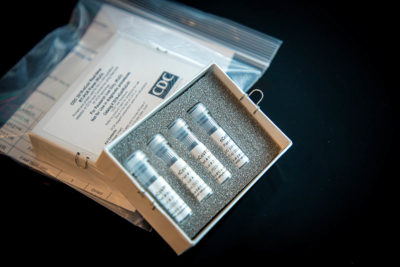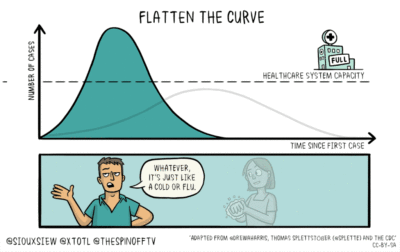In urgent messaging, health experts at all levels, from global and national experts, all the way to the local county level, are sounding the alarm that the coronavirus pandemic known as COVID-19 represents a coming tragedy of almost unimaginable scale. This is our reality even as we continue to follow strict social distancing guidelines. With three out of every four people in America now under stay-at-home orders, experts now say that as many as 150 million people could become infected with the virus.
According to infectious disease expert and Director of the National Institute of Allergy and Infectious Diseases Dr Anthony Fauci, “if we do everything perfectly, we hope we can hold down the number of deaths in this country to 100,000 to 200,000 people.”
Since when did losing “only 100,000′ Americans become a best-case scenario? Since we got the news that if we don’t do what we can now to flatten the curve, Fauci and other health experts say, within the next few months we are looking at the death of 1.5 to 2.2 million people; our family members, our friends, our co-workers — and ourselves.
The urgent message to stay home and save lives now underlies the efforts being made at every level of government, right down to our local health department.
“Every person who is infected with the coronavirus infects four to five more people,” said Chaffee Director of Public Health (CCPH) Andrea Carlstrom during a conference call on Monday. “This disease can move rapidly. It takes just two weeks from getting sick to death for the severe cases. The data tells us that our stay-at-home order is reducing morbidity by 80 percent. At the state level the projection is that if we do not social distancing we could see 23,000 deaths in Colorado by June 1 from COVID-19.”
The encouragement of extreme social distancing practices is focused on flattening the wave of cases likely to flood hospitals nationwide, and statewide. The goal is to reduce the surge of positive cases hitting the healthcare system all at once. This has been occurring in other countries such as Italy and Spain, as well as in Washington state, New York state and now in Louisiana and several other metro areas. In New York City, emergency hospitals have been set up in Central Park and vacant sports arenas. Military hospital ships have arrived in New York Harbor, and the Port of Los Angeles.
“This virus is spread with a lot of asymptomatic people and doesn’t show until it hits vulnerable populations. It is making its way into rural areas,” said Dr. Deborah Birx, who serves on the President’s National COVID-19 Task Force. “By the time you see it, it has penetrated your community pretty significantly.”
Health officials are taking seriously the projected peak of cases – expected over the next 30 to 60 days. Carlstrom says there is a small subset of health and medical emergency services focused on planning for alternate care facilities. The prospect of a surge is finally being addressed by Colorado and Chaffee County officials.
“We’re expecting to receive a surge in the county and beyond,” said Carlstrom. “CCPH is working with Heart of the Rockies Regional Medical Center (HRRMC), Emergency Management, EMS, and other stakeholders to secure a local location and resources to plan for a surge in COVID-19 patients. This is a top priority,” said Carlstrom.

Chaffee Fairgrounds have been used for recent emergencies; in Sept. 2019, the Decker Fire incident command set up at the Chaffee County. Now the main buildings at the fairgrounds might be used for overflow alternative care space to deal with coronavirus pandemic cases. Photos by Jan Wondra.
“Regardless of when [it occurs] we need alternate care facilities,” she added. “I’ve spoken with the hospital. They do have some good plans to use clinics and the wings not being used at the hospital. It is in our best interest to ID a location such as the fairgrounds, to come up with a plan so if we had to – say overnight or in the space of a week – carry out an alternate care site, we could.”
Chaffee Chair of the Board of County Commissioners Greg Felt said that he, Director of General Administration Bob Christiansen, and Finance Director Dan Short had already talked about converting the Chaffee County Fairgrounds buildings into alternate care facilities. “We’re getting Bob [Heart of the Rockies Regional Medical Center CEO Bob Morasko] out from the hospital to tour the facilities we have and how to use them.”
Felt asked how quickly the county could accelerate getting utilities out to the north building to make that significant square footage available and was told that within a few days this might be possible. The county is following up on a FEMA (Federal Emergency Management Administration) funding opportunity to quickly convert these areas into treatment facilities.
(It should be noted that the county has been talking for months about the need to get utilities in place at the north building, but the project has appeared stalled as cost estimates have been developed. AVV has been asking about coronavirus surge scenario planning for treatment facilities for the past three weeks.)
The lack of test kits across the state continues. In a communications sent Monday evening, Carlstrom said the state has distributed 4,200 testing kits and PPE (Personal Protective Equipment) to local public health agencies in El Paso, Larimer and Mesa Counties. The counties will use these supplies to test healthcare workers and first responders across their regions.
The Colorado Department of Public Health and Environment (CDPHE) lab also sent 300 testing kits to the Ute Mountain Ute tribe. More testing kits will be provided to local public health agencies once those supplies are received from FEMA.
“Right now, due to limited supplies of testing kits and personal protective equipment, testing needs to be focused on the people who are the most at-risk from this disease and the people in charge of caring for and keeping the rest of us safe,” said Scott Bookman, CDPHE COVID-19 Incident Commander. “It’s important to protect the most critical element of the healthcare system. We are working hard to get the supplies and capacity to move to broader public testing, but until then our message remains the same: if you have only mild symptoms, self-isolate and don’t wait for a test.”
While Carlstrom says that 137 people have been tested in the county, that leaves around 21,000 county residents who haven’t been tested.
 As of noon Tuesday, there are more than 179,000 people across the U.S. who have the virus. Even with social distancing measures across many states, the number appears to be doubling every four to five days. More than 3,500 have already died – more than during the 911 attacks. The situation has doctors and hospitals crying out for personal protective equipment (PPE), working wearing garbage bags and bandanas.
As of noon Tuesday, there are more than 179,000 people across the U.S. who have the virus. Even with social distancing measures across many states, the number appears to be doubling every four to five days. More than 3,500 have already died – more than during the 911 attacks. The situation has doctors and hospitals crying out for personal protective equipment (PPE), working wearing garbage bags and bandanas.
As bad as things could get over the next six to eight weeks, things could get even worse. According to Fauci, this could be just the first wave of this pandemic. Scientists now say that this virus – for which there is no vaccine and no herd immunity – exhibits signs that it can spread seasonally; meaning we may face a COVID-19 wave this fall as well.
For those who may believe that the scientists are overplaying this, Carl Bergstrom. a theoretical and evolutionary biologist and a professor at the University of Washington in Seattle, Washington has put out some pretty convincing rebuttal. He points out that health crisis will not disappear any time soon; after this first wave we face a second one, and 97 percent of the American population will still be at risk.
Medical professionals on the front lines of this pandemic are confronting something that most have never seen; including emergency room doctors at the epicenter in New York City.
“I’m seeing EMS stretchers lined up down the block for four or five hours, waiting to get into a hospital … hospital wards, medical floors, ICUs, hallways full of patients,” said NYC Emergency Room Doctor Calvin Sun, speaking to NBC News. “My fellow doctors and nurses are themselves on life support – I’ve treated my own colleagues. We could have prevented all this if we had been adequately protected from day one. We’re exposed – without PPE. There’s a sense of guilt a doctor or nurse feels; we put ourselves in harms way to take care of our patients. We are becoming patients ourselves. Our healthcare system is bursting at the seams….”
When scientifically-trained health care professionals tear up talking about the crisis, American’s should perhaps pay attention. “This is America – and we are acting like this is the third world,” said Dr. Colleen Smith, an Elmhurst Hospital Emergency Room Doctor. “People are dying, and we don’t have the equipment we need.”








Recent Comments